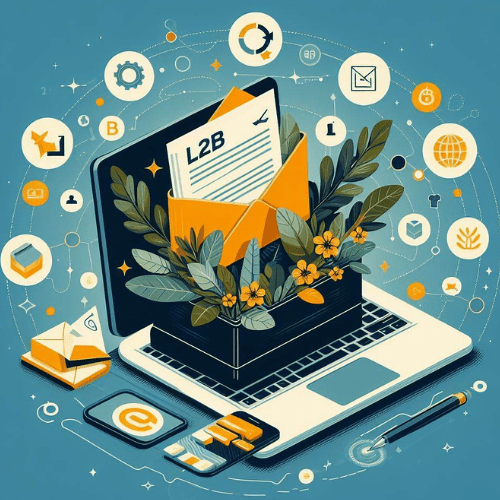
What’s Inside:
- B2B lead nurturing best practices
- Segmenting your leads
- Timely follow-ups
- B2B lead nurturing strategies
- Use of CRM tools
- A/B testing
- B2B lead nurturing email examples
- Welcome emails
- Follow-up emails
- Final reflections
In the fast-paced world of B2B marketing, catching a potential client’s attention is only half the battle. The real challenge lies in keeping that interest alive and transforming it into a profitable relationship. This is where B2B lead nurturing comes into play. More than just a buzzword, lead nurturing is the linchpin that connects the dots between acquiring a lead and closing a sale. In other words, it’s not just about capturing leads; it’s about cultivating them until they are sales-ready.
Navigating the complex landscape of B2B lead nurturing can be overwhelming. But fear not! In this comprehensive guide, we will dissect the subject thoroughly. We’ll start by uncovering best practices that set the gold standard in the industry. Next, we’ll delve into strategic planning, exploring how to construct lead nurturing strategies that actually work. Finally, we’ll take a close look at B2B lead nurturing email examples to demonstrate the art of crafting impactful messages. By the end of this article, you’ll be well-equipped to transform your cold leads into sales opportunities.
B2B Lead Nurturing Best Practices
In the ever-changing realm of B2B marketing, relying solely on instinct or gut feeling is a recipe for inconsistency. This is why adhering to best practices is not just advisable; it’s necessary. B2B lead nurturing best practices serve as the compass that guides your efforts, ensuring you’re not wandering aimlessly in the dark. They allow for a systematic approach, making your lead nurturing campaigns more measurable, scalable, and, most importantly, effective.
Identifying these best practices can be a complex task. While some are universal, others can vary depending on your industry, target audience, or even the specific objectives of your campaigns. The key lies in research and analytics—both of your past campaigns and industry standards.

Key Indicators to Identify Best Practices:
- High Engagement Rates
- Low Unsubscribe or Churn Rates
- Improved Sales Metrics
- Customer Testimonials and Feedback
Segment Your Leads
In the world of B2B lead nurturing, one-size-fits-all is a myth that has long been debunked. The importance of lead segmentation cannot be overstated. By dividing your leads into smaller groups based on specific criteria—such as industry, job title, or engagement level—you can tailor your messaging and content to meet the unique needs and pain points of each segment. This not only increases the relevance of your communications but also significantly boosts engagement rates, setting the stage for a more personalized and effective nurturing process.
Timely Follow-Ups
Time is of the essence in B2B lead nurturing. Waiting too long to engage with a lead can result in a lost opportunity while being too aggressive can be a turn-off. Striking the right balance in your follow-up timing is crucial for keeping a lead’s interest piqued. Automated workflows can help manage this delicate balance, ensuring that you reach out at the optimal moments when a lead is most likely to engage. The art of timely follow-ups transforms the static concept of lead nurturing into a dynamic, responsive process that adapts to each lead’s journey.
B2B Lead Nurturing Strategies
Diving headfirst into lead nurturing without a solid strategy is akin to sailing without a compass—you might move, but you’re unlikely to reach your desired destination. Crafting a well-thought-out strategy begins with defining clear objectives. Are you looking to increase engagement, reduce sales cycles, or perhaps improve customer retention? Once your goals are set, these become the anchor points around which your tactics and actions revolve.

Effective B2B lead nurturing strategies aren’t built overnight, and it’s much more than just sending a few emails. It involves multiple components that all work in harmony. You’ll need a mix of content types, from blogs and webinars to case studies, each tailored to different stages of the buyer’s journey. Automation tools like CRM systems can streamline this process, while analytics platforms can provide insights into your campaign’s performance, allowing for real-time adjustments. Essential components often include targeted messaging, multi-channel approaches, and data-driven decision-making. When these elements align, you’re not just nurturing leads but cultivating relationships.
Use of CRM Tools
Customer Relationship Management (CRM) tools are not just a nice-to-have; they’re a necessity in the world of B2B lead nurturing. These platforms allow you to store and manage lead information, track interactions, and automate tasks, thereby streamlining your overall strategy. By centralizing data and providing actionable insights, CRM tools enable you to make data-driven decisions and tailor your nurturing efforts more effectively.
Key Benefits of Using CRM Tools in Lead Nurturing:
- Centralized Data Repository: Store all lead information in one place for easy access.
- Automation: Automate repetitive tasks like email sending and follow-ups.
- Personalization: Use data to tailor messages and offers to specific lead segments.
- Reporting: Gain insights through analytics and reporting features for continuous optimization.
A/B Testing
A/B testing is not just a tactic; it’s an ongoing strategy for continuous improvement in your lead nurturing campaigns. By creating two versions of an email, landing page, or even a call-to-action, and comparing their performance, you get invaluable data on what resonates with your audience. This empowers you to make data-backed decisions, refine your strategies, and optimize for better results. In a domain as complex and multifaceted, as B2B lead nurturing, A/B testing serves as your experimental lab, allowing you to fine-tune and adapt to the ever-changing landscape.
B2B Lead Nurturing Email Examples

Despite the proliferation of communication channels, email remains an indispensable tool in B2B lead nurturing. Its enduring relevance can be attributed to its directness and versatility. Whether it’s for sending product updates, sharing valuable content, or initiating sales conversations, email gives you a personal, one-on-one channel to your leads. Plus, it’s easier to track and measure compared to other channels, offering a wealth of data that can be analyzed to fine-tune your strategies.
Crafting emails that resonate with your leads goes beyond just slick copywriting; it’s a blend of relevance, timing, and value. The first step is to understand your audience’s pain points and needs.
Personalization tokens, such as the lead’s name or company, can make the email more engaging, but real personalization involves tailoring the content and call-to-action to match the lead’s stage in the buyer’s journey. Leverage the power of storytelling to connect on an emotional level and include clear, compelling calls-to-action that guide the lead to the next steps. When done correctly, emails become more than just messages; they become an integral part of your lead nurturing ecosystem. A few B2B lead nurturing email examples include:
The Welcome Email
The welcome email is often your first touchpoint with a lead, setting the tone for all future interactions. Crafting an engaging and informative welcome email can make or break your nurturing efforts, as first impressions are lasting. With the right elements in place, your welcome email becomes not just a greeting but a powerful tool that instills trust and piques interest.
Key Elements of an Effective Welcome Email:
- A warm and friendly greeting: Humanizes your brand.
- Brief introduction: Summarizes what your company offers.
- Call-to-Action: Guides the lead to the next step, whether it’s a product demo, a content download, or another engagement point.
- Contact Information: Allows leads to reach out with questions or concerns.
The Follow-Up Email
In the dance of lead nurturing, the follow-up email is your next step. Sent after an initial interaction—be it a download, a webinar, or a sales call—this email aims to keep the conversation alive. Well-crafted follow-up emails can reignite interest, provide additional value, and pave the way for deeper engagement. Essentially, it keeps the narrative moving forward, bolstering the relationship between your brand and the lead.
Components of an Effective Follow-Up Email:
- Subject Line: Should grab attention and reference the previous interaction.
- Value Proposition: Offer something new that enhances the original point of contact, like a helpful resource or a limited-time offer.
- Call-to-Action: Directs the lead on what to do next, such as scheduling a call or visiting a landing page.
- A Personal Touch: Whether it’s referencing the previous interaction or offering tailored advice, a personal touch can make all the difference.
Final Reflections
B2B lead nurturing is not a one-size-fits-all endeavor; it requires a well-thought-out strategy and tactical execution. From understanding the best practices that set the foundation for your efforts to leveraging CRM tools and A/B testing for ongoing refinement, each component plays a critical role in your success. Strategies such as segmentation and timely follow-ups fine-tune your approach, ensuring each lead gets the personalized treatment they require. And let’s not forget the role of email, a stalwart in the B2B world, which allows for highly targeted and personalized engagement with your leads.
Mastering B2B lead nurturing is more than just a marketing strategy; it’s a business imperative. In a highly competitive landscape, effective lead nurturing can mean the difference between a missed opportunity and a closed sale. It’s about building relationships, not just transactions. By honing your nurturing strategies, you’re not just capturing leads; you’re securing long-term business relationships.
Ready to Supercharge Your B2B Lead Nurturing Game? Let CyberTheory Elevate You
You’ve taken the first step by educating yourself on the intricacies of B2B lead nurturing, but the journey doesn’t stop here. Ready to implement these strategies into your own marketing campaign? CyberTheory can help. Our range of services, from strategy consultation to hands-on execution, will ensure you’re not just nurturing leads, but converting them into loyal customers.
Contact CyberTheory today and take your B2B lead nurturing efforts to the next level.